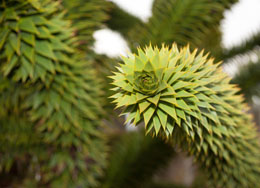If you are looking for some hedges to give you some kind of privacy, you can go for small evergreen shrubs. Here, we give you a list of a few varieties that can be used to create a boundary for your home.

With the presence of green leaves throughout the year, evergreen shrubs and bushes have become some of the most popular plants to be used as hedges. They bear needle-shaped leaves and can be easily trimmed and shaped. There are some bushes which blend well with other flowering plants. Hence, whenever you plant these, you should try and place them in combination with flowering plants. These shrubs need acidic soil to thrive. If the soil in your garden is not acidic, you would have to plant them in pots with ericaceous compost.
Requirements for Planting
Shrubs of the evergreen category can be planted at any time of the year provided that the soil is not frozen or waterlogged. You just need to dig a hole about twice the size of the root ball. In case the soil in your garden is not fertile, you can mix it with compost, which would help the roots to grow well. Separate a few roots before placing the root ball in the hole. Fill the hole with soil and compost, and firm the soil so that the plant stands vertically. Make sure that you water it well, especially during summer months so that it doesn't dry out. If you plant it in winter or autumn, you wouldn't need to water it so regularly.
Monkey Puzzle
Most common amongst these shrubs is the Chilean Pine, which is also called the Monkey Puzzle. Initially, the plant grows very slowly. Later, it grows a bit faster and goes on to become quite large. Make sure that you plant it in an open space, as it propagates very fast. The soil should be reasonably fertile and acidic in nature. The only thing it can't resist is disturbance to the roots. So, when you replant it from a nursery in your garden, make sure that you bury the pot along with the roots. Over time, the pot would disintegrate, and the roots would grow well.
Aucuba rozannie
This plant is a compact shrub with glossy leaves. It produces bright, red berries during winters, which ripen by the arrival of spring. This shrub can tolerate any kind of climatic and soil conditions. However, to be on the safer side, make sure that you don't expose the plant too much to sunshine when it's young, as it may be harmful. The only thing it can't withstand is waterlogged soil, so make sure that the soil is well drained.
Aucuba rozannie grows to about a meter in about 5 years.
Azalea japonica ardeur
This is another variety that is quite hardy and can withstand fluctuations of temperature. In spring, it produces red flowers, and the leaves are dark green. If you opt to grow it in a pot, make sure that you mix ericaceous compost with the soil. Moreover, you should water the plant well, especially during the warm summer months. At times, the leaves may become yellow, and in such a case, you need to mix iron sulfate with water before you water the plant.
Berberis buxiflora nana
The
berberis buxiflora nana produces box-like, light green leaves and small yellow flowers which look like hanging teardrops. These flowers are produced mostly in the summers and the spring. You can plant this shrub in shady as well as sunny places, but make sure that the soil is well drained. It grows very slowly and can grow to just about 45 centimeters in about 10 years.
You need to take good care of these plants, especially during their formative years. You can prune them at regular intervals so that they remain at a particularly desirable height. Go for these listed evergreen shrubs if you want to spruce up your garden and get envious looks from your neighbors.






 With the presence of green leaves throughout the year, evergreen shrubs and bushes have become some of the most popular plants to be used as hedges. They bear needle-shaped leaves and can be easily trimmed and shaped. There are some bushes which blend well with other flowering plants. Hence, whenever you plant these, you should try and place them in combination with flowering plants. These shrubs need acidic soil to thrive. If the soil in your garden is not acidic, you would have to plant them in pots with ericaceous compost.
With the presence of green leaves throughout the year, evergreen shrubs and bushes have become some of the most popular plants to be used as hedges. They bear needle-shaped leaves and can be easily trimmed and shaped. There are some bushes which blend well with other flowering plants. Hence, whenever you plant these, you should try and place them in combination with flowering plants. These shrubs need acidic soil to thrive. If the soil in your garden is not acidic, you would have to plant them in pots with ericaceous compost.